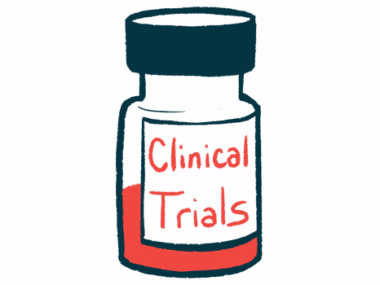Ingrezza’s effects on chorea become stronger over time: Trial analysis
Effects found strongest during maintenance period of Phase 3 KINECT-HD trial
Written by |

The effects of Ingrezza (valbenazine) on Huntington’s disease-associated chorea grew increasingly stronger over the course of the three-month Phase 3 KINECT-HD clinical trial, according to a post-hoc analysis.
A post-hoc analysis is one planned and conducted after the trial has been completed.
“This post-hoc analysis of the KINECT-HD data gives providers more insight into the improvements in Huntington’s disease chorea observed over the course of the phase 3 clinical trial following treatment with Ingrezza,” Eiry Roberts, MD, chief medical officer at Neurocrine Biosciences, the therapy’s developer, said in a statement emailed to Huntington’s Disease News.
In addition, data from KINECT-HD (NCT04102579) and its open-label extension study, called KINECT-HD2 (NCT04400331), showed that rates of drowsiness — Ingrezza’s most common side effect — tended to decrease the longer patients were treated.
These findings were presented in two posters at the International Association of Parkinsonism and Related Disorders 2024 Congress, held May 19-22, in Lisbon, Portugal.
Chorea, characterized by involuntary and uncontrolled movements, is among the most common symptoms of Huntington’s, affecting somewhere around 90% of patients.
Ingrezza aims to lower levels of dopamine
Ingrezza aims to lower levels of dopamine, a major brain signaling chemical whose high levels have been associated with chorea, by suppressing a protein called VMAT2. By reducing dopamine levels, the therapy is expected to ease the troublesome symptom.
Taken as a single oral capsule once a day, the therapy was approved last year in the U.S. for Huntington’s chorea. Ingrezza Sprinkle, a granulated formulation that can be sprinkled on food, was also cleared in April.
KINECT-HD enrolled 128 adults with Huntington’s-associated chorea who were randomly assigned to receive a once-daily oral capsule of either Ingrezza or a placebo for 12 weeks (three months). The starting dose of Ingrezza was 40 mg, which was gradually increased to a desired maintenance dose of 80 mg.
Results showed Ingrezza led to significant reductions in chorea, as assessed by changes in the Unified Huntington’s Disease Rating Scale’s Total Maximal Chorea (TMC) scores. These benefits were observed as soon as two weeks after treatment started, when patients were still on the initial 40 mg dose, and were sustained throughout the trial.
Ingrezza associated with reduced patient-reported disease burden
Ingrezza was also associated with reduced patient-reported disease burden and overall improved health as reported by both clinicians and patients.
Now, Neurocrine has conducted an analysis to look more closely at the effect sizes associated with TMC scores throughout the KINECT-HD trial.
Effect sizes “represent the magnitude of the clinical response to treatment relative to placebo and allow for comparisons across clinical trials or against standard-of-care interventions using published data,” the researchers wrote in the poster “Efficacy of Once-Daily Valbenazine in Adults with Chorea Associated with Huntington’s Disease: Effect Sizes Over Time.”
Results from the analysis showed effect sizes on TMC scores progressively increased throughout the 12-week trial, meaning Ingrezza’s effects on chorea relative to placebo continuously became stronger. Effect sizes were largest during the study’s maintenance phase when patients were taking the target 80 mg dose.
“The effect size increased as patients continued therapy, with the largest effect size observed during the maintenance period,” Roberts said.
Those completing KINECT-HD could opt to enroll in the extension KINECT-HD2 trial, in which all receive Ingrezza for up to three years. KINECT-HD2 also involves newly enrolled adults with Huntington’s chorea.
Interim data show benefits of Ingrezza maintained for at least 1 year
Interim data show the benefits of Ingrezza have been maintained for at least a year, and are not affected by simultaneous use of antipsychotic medications.
In the poster “Somnolence-Related Events Over Time During Valbenazine Treatment for Chorea Associated with Huntington’s Disease,” researchers presented the rates of somnolence-associated side effects across KINECT-HD and the first year of KINECT-HD2.
Somnolence, referring broadly to the state of being sleepy or drowsy, was the most common side effect of Ingrezza reported in KINECT-HD, in 15.6% of participants.
Results showed all somnolence-associated side effects, including fatigue, sedation, lethargy, and excessive sleepiness, were mild or moderate in severity. Rates of somnolence-related events were highest in the first weeks of either study, but became less frequent the longer patients were treated.
Specifically, 31.3% of KINECT-HD participants experienced a somnolence-related event in the first two weeks, versus 8.7% from two months onward. Likewise, 30.8% of those in extension trial experienced such events in the first two weeks, compared with 9% between weeks 27-52 (about six months to a year).
In both KINECT-HD and KINECT-HD2, somnolence-related adverse events “were mostly reported in the first 2 weeks following initiation of [Ingrezza] treatment; incidence was lower during maintenance treatment,” the researchers wrote in the poster.
Most participants who experienced these side effects opted to continue treatment.







